Financial Analysis Individual Assignment
VerifiedAdded on 2021/06/30
|9
|2426
|31
AI Summary
Contribute Materials
Your contribution can guide someone’s learning journey. Share your
documents today.

FINANCIAL ANALYSIS
INDIVIDUAL ASSIGNMENT
Name: Nguyen Ngoc Ky Thoa
ID number: SS140277
Class: IB1401
1
INDIVIDUAL ASSIGNMENT
Name: Nguyen Ngoc Ky Thoa
ID number: SS140277
Class: IB1401
1
Secure Best Marks with AI Grader
Need help grading? Try our AI Grader for instant feedback on your assignments.
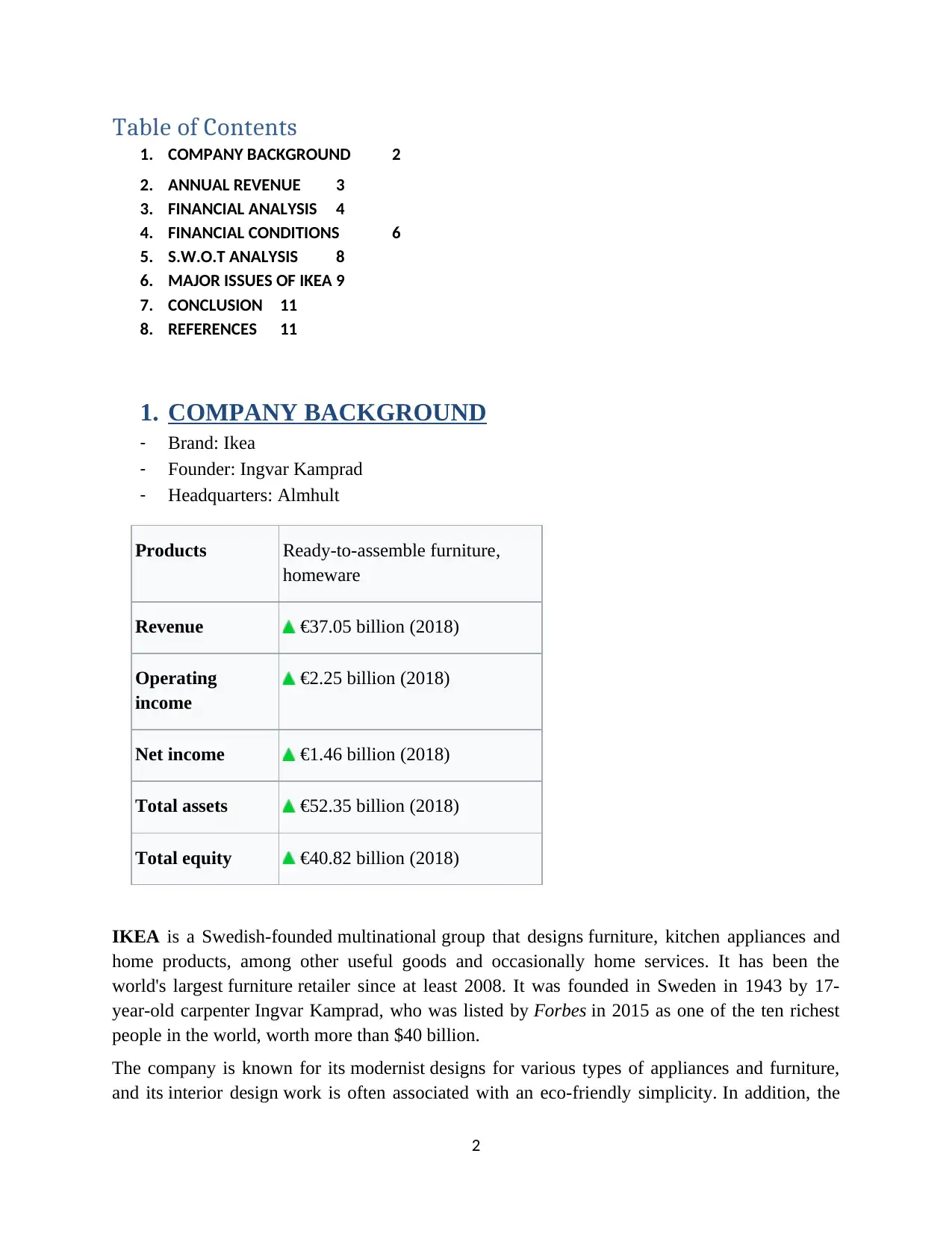
Table of Contents
1. COMPANY BACKGROUND 2
2. ANNUAL REVENUE 3
3. FINANCIAL ANALYSIS 4
4. FINANCIAL CONDITIONS 6
5. S.W.O.T ANALYSIS 8
6. MAJOR ISSUES OF IKEA 9
7. CONCLUSION 11
8. REFERENCES 11
1. COMPANY BACKGROUND
- Brand: Ikea
- Founder: Ingvar Kamprad
- Headquarters: Almhult
Products Ready-to-assemble furniture,
homeware
Revenue €37.05 billion (2018)
Operating
income
€2.25 billion (2018)
Net income €1.46 billion (2018)
Total assets €52.35 billion (2018)
Total equity €40.82 billion (2018)
IKEA is a Swedish-founded multinational group that designs furniture, kitchen appliances and
home products, among other useful goods and occasionally home services. It has been the
world's largest furniture retailer since at least 2008. It was founded in Sweden in 1943 by 17-
year-old carpenter Ingvar Kamprad, who was listed by Forbes in 2015 as one of the ten richest
people in the world, worth more than $40 billion.
The company is known for its modernist designs for various types of appliances and furniture,
and its interior design work is often associated with an eco-friendly simplicity. In addition, the
2
1. COMPANY BACKGROUND 2
2. ANNUAL REVENUE 3
3. FINANCIAL ANALYSIS 4
4. FINANCIAL CONDITIONS 6
5. S.W.O.T ANALYSIS 8
6. MAJOR ISSUES OF IKEA 9
7. CONCLUSION 11
8. REFERENCES 11
1. COMPANY BACKGROUND
- Brand: Ikea
- Founder: Ingvar Kamprad
- Headquarters: Almhult
Products Ready-to-assemble furniture,
homeware
Revenue €37.05 billion (2018)
Operating
income
€2.25 billion (2018)
Net income €1.46 billion (2018)
Total assets €52.35 billion (2018)
Total equity €40.82 billion (2018)
IKEA is a Swedish-founded multinational group that designs furniture, kitchen appliances and
home products, among other useful goods and occasionally home services. It has been the
world's largest furniture retailer since at least 2008. It was founded in Sweden in 1943 by 17-
year-old carpenter Ingvar Kamprad, who was listed by Forbes in 2015 as one of the ten richest
people in the world, worth more than $40 billion.
The company is known for its modernist designs for various types of appliances and furniture,
and its interior design work is often associated with an eco-friendly simplicity. In addition, the
2
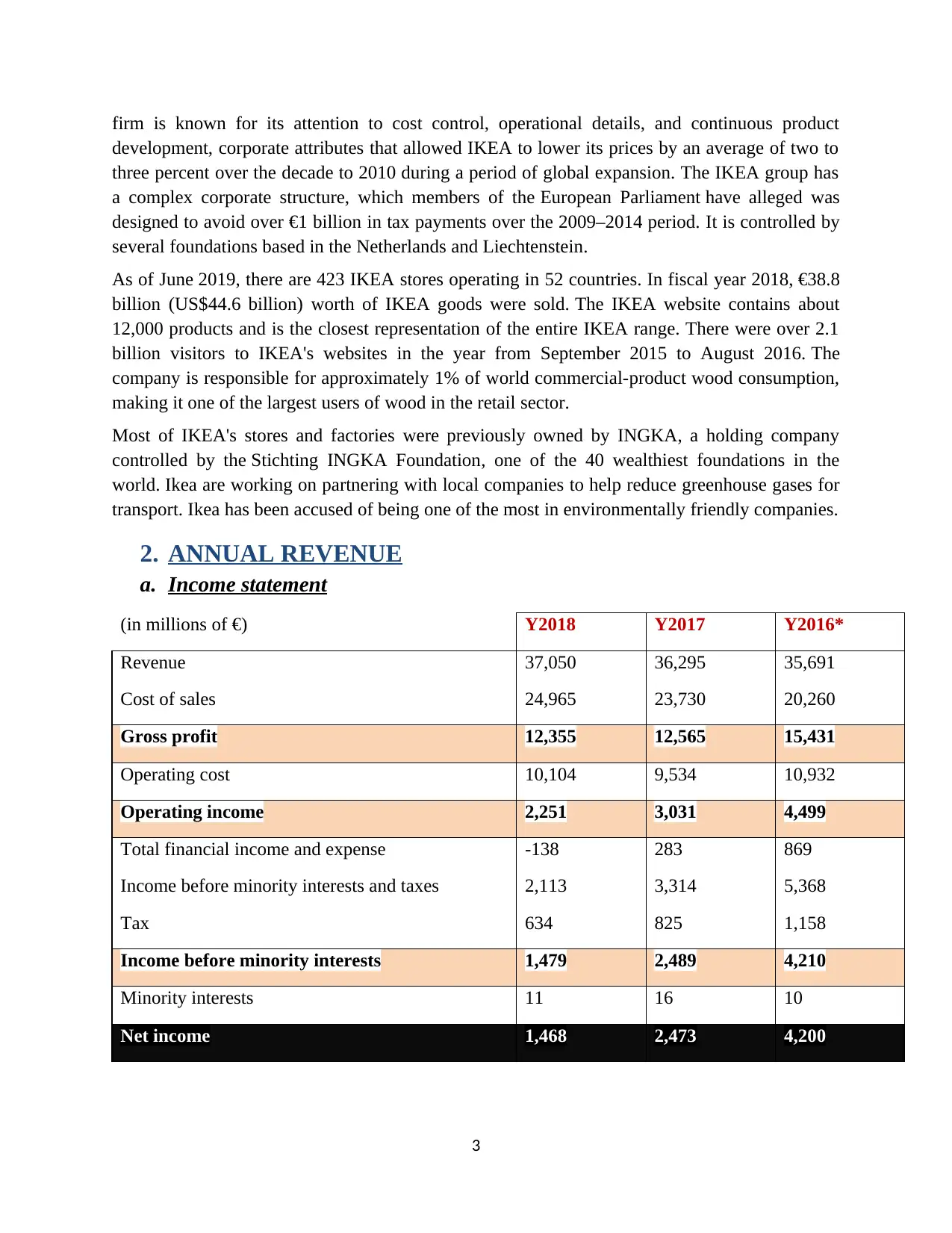
firm is known for its attention to cost control, operational details, and continuous product
development, corporate attributes that allowed IKEA to lower its prices by an average of two to
three percent over the decade to 2010 during a period of global expansion. The IKEA group has
a complex corporate structure, which members of the European Parliament have alleged was
designed to avoid over €1 billion in tax payments over the 2009–2014 period. It is controlled by
several foundations based in the Netherlands and Liechtenstein.
As of June 2019, there are 423 IKEA stores operating in 52 countries. In fiscal year 2018, €38.8
billion (US$44.6 billion) worth of IKEA goods were sold. The IKEA website contains about
12,000 products and is the closest representation of the entire IKEA range. There were over 2.1
billion visitors to IKEA's websites in the year from September 2015 to August 2016. The
company is responsible for approximately 1% of world commercial-product wood consumption,
making it one of the largest users of wood in the retail sector.
Most of IKEA's stores and factories were previously owned by INGKA, a holding company
controlled by the Stichting INGKA Foundation, one of the 40 wealthiest foundations in the
world. Ikea are working on partnering with local companies to help reduce greenhouse gases for
transport. Ikea has been accused of being one of the most in environmentally friendly companies.
2. ANNUAL REVENUE
a. Income statement
(in millions of €) Y2018 Y2017 Y2016*
Revenue 37,050 36,295 35,691
Cost of sales 24,965 23,730 20,260
Gross profit 12,355 12,565 15,431
Operating cost 10,104 9,534 10,932
Operating income 2,251 3,031 4,499
Total financial income and expense -138 283 869
Income before minority interests and taxes 2,113 3,314 5,368
Tax 634 825 1,158
Income before minority interests 1,479 2,489 4,210
Minority interests 11 16 10
Net income 1,468 2,473 4,200
3
development, corporate attributes that allowed IKEA to lower its prices by an average of two to
three percent over the decade to 2010 during a period of global expansion. The IKEA group has
a complex corporate structure, which members of the European Parliament have alleged was
designed to avoid over €1 billion in tax payments over the 2009–2014 period. It is controlled by
several foundations based in the Netherlands and Liechtenstein.
As of June 2019, there are 423 IKEA stores operating in 52 countries. In fiscal year 2018, €38.8
billion (US$44.6 billion) worth of IKEA goods were sold. The IKEA website contains about
12,000 products and is the closest representation of the entire IKEA range. There were over 2.1
billion visitors to IKEA's websites in the year from September 2015 to August 2016. The
company is responsible for approximately 1% of world commercial-product wood consumption,
making it one of the largest users of wood in the retail sector.
Most of IKEA's stores and factories were previously owned by INGKA, a holding company
controlled by the Stichting INGKA Foundation, one of the 40 wealthiest foundations in the
world. Ikea are working on partnering with local companies to help reduce greenhouse gases for
transport. Ikea has been accused of being one of the most in environmentally friendly companies.
2. ANNUAL REVENUE
a. Income statement
(in millions of €) Y2018 Y2017 Y2016*
Revenue 37,050 36,295 35,691
Cost of sales 24,965 23,730 20,260
Gross profit 12,355 12,565 15,431
Operating cost 10,104 9,534 10,932
Operating income 2,251 3,031 4,499
Total financial income and expense -138 283 869
Income before minority interests and taxes 2,113 3,314 5,368
Tax 634 825 1,158
Income before minority interests 1,479 2,489 4,210
Minority interests 11 16 10
Net income 1,468 2,473 4,200
3
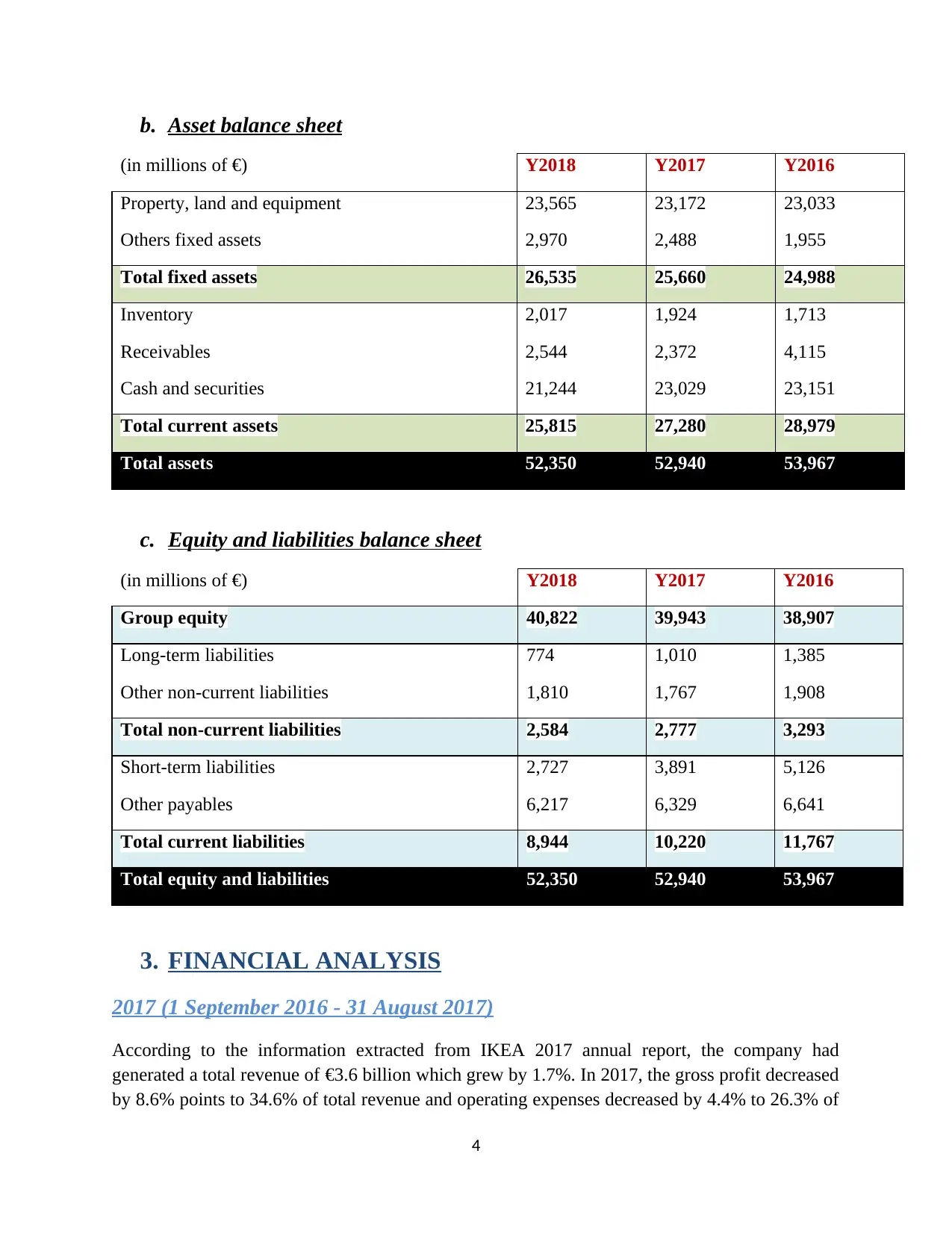
b. Asset balance sheet
(in millions of €) Y2018 Y2017 Y2016
Property, land and equipment 23,565 23,172 23,033
Others fixed assets 2,970 2,488 1,955
Total fixed assets 26,535 25,660 24,988
Inventory 2,017 1,924 1,713
Receivables 2,544 2,372 4,115
Cash and securities 21,244 23,029 23,151
Total current assets 25,815 27,280 28,979
Total assets 52,350 52,940 53,967
c. Equity and liabilities balance sheet
(in millions of €) Y2018 Y2017 Y2016
Group equity 40,822 39,943 38,907
Long-term liabilities 774 1,010 1,385
Other non-current liabilities 1,810 1,767 1,908
Total non-current liabilities 2,584 2,777 3,293
Short-term liabilities 2,727 3,891 5,126
Other payables 6,217 6,329 6,641
Total current liabilities 8,944 10,220 11,767
Total equity and liabilities 52,350 52,940 53,967
3. FINANCIAL ANALYSIS
2017 (1 September 2016 - 31 August 2017)
According to the information extracted from IKEA 2017 annual report, the company had
generated a total revenue of €3.6 billion which grew by 1.7%. In 2017, the gross profit decreased
by 8.6% points to 34.6% of total revenue and operating expenses decreased by 4.4% to 26.3% of
4
(in millions of €) Y2018 Y2017 Y2016
Property, land and equipment 23,565 23,172 23,033
Others fixed assets 2,970 2,488 1,955
Total fixed assets 26,535 25,660 24,988
Inventory 2,017 1,924 1,713
Receivables 2,544 2,372 4,115
Cash and securities 21,244 23,029 23,151
Total current assets 25,815 27,280 28,979
Total assets 52,350 52,940 53,967
c. Equity and liabilities balance sheet
(in millions of €) Y2018 Y2017 Y2016
Group equity 40,822 39,943 38,907
Long-term liabilities 774 1,010 1,385
Other non-current liabilities 1,810 1,767 1,908
Total non-current liabilities 2,584 2,777 3,293
Short-term liabilities 2,727 3,891 5,126
Other payables 6,217 6,329 6,641
Total current liabilities 8,944 10,220 11,767
Total equity and liabilities 52,350 52,940 53,967
3. FINANCIAL ANALYSIS
2017 (1 September 2016 - 31 August 2017)
According to the information extracted from IKEA 2017 annual report, the company had
generated a total revenue of €3.6 billion which grew by 1.7%. In 2017, the gross profit decreased
by 8.6% points to 34.6% of total revenue and operating expenses decreased by 4.4% to 26.3% of
4
Secure Best Marks with AI Grader
Need help grading? Try our AI Grader for instant feedback on your assignments.
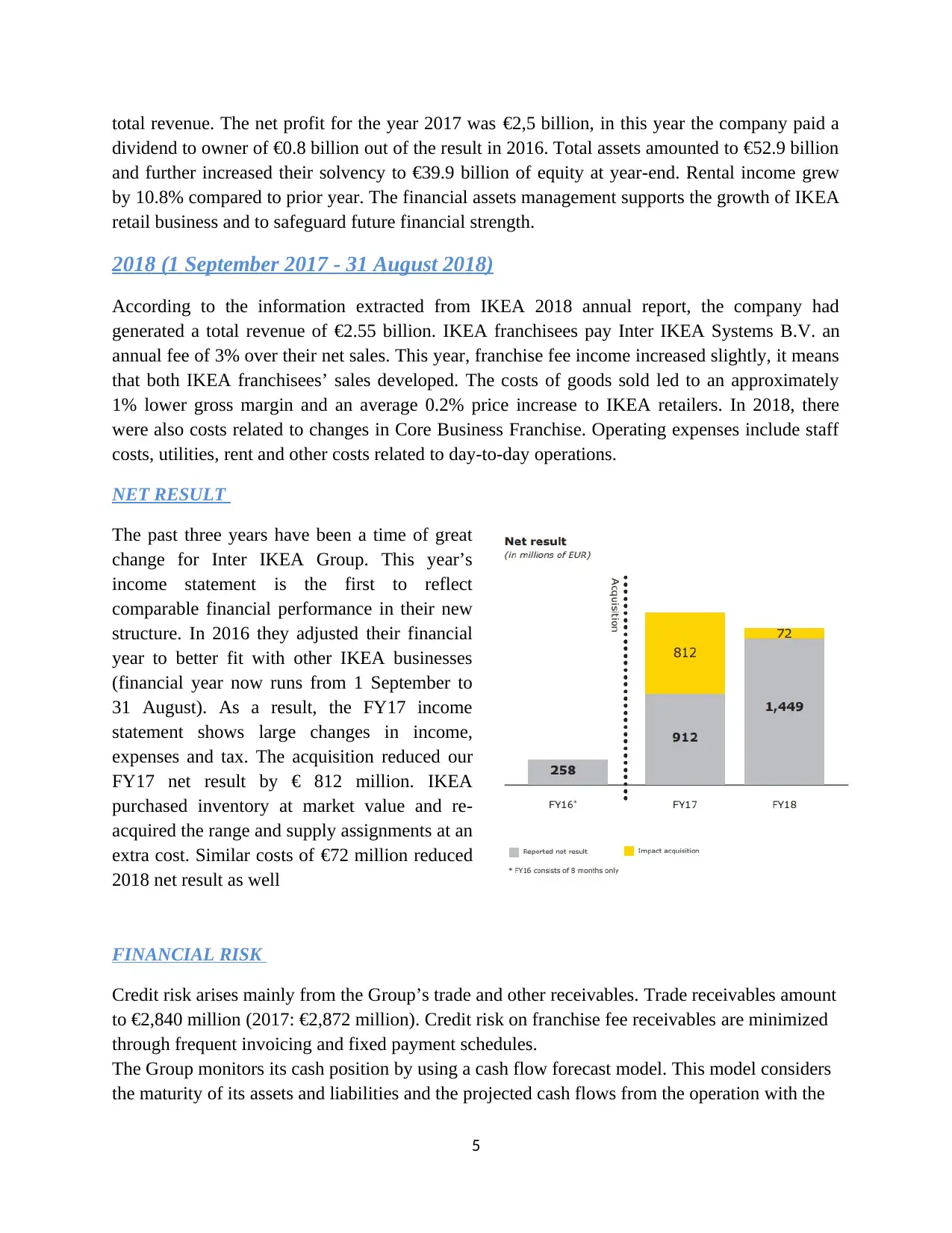
total revenue. The net profit for the year 2017 was €2,5 billion, in this year the company paid a
dividend to owner of €0.8 billion out of the result in 2016. Total assets amounted to €52.9 billion
and further increased their solvency to €39.9 billion of equity at year-end. Rental income grew
by 10.8% compared to prior year. The financial assets management supports the growth of IKEA
retail business and to safeguard future financial strength.
2018 (1 September 2017 - 31 August 2018)
According to the information extracted from IKEA 2018 annual report, the company had
generated a total revenue of €2.55 billion. IKEA franchisees pay Inter IKEA Systems B.V. an
annual fee of 3% over their net sales. This year, franchise fee income increased slightly, it means
that both IKEA franchisees’ sales developed. The costs of goods sold led to an approximately
1% lower gross margin and an average 0.2% price increase to IKEA retailers. In 2018, there
were also costs related to changes in Core Business Franchise. Operating expenses include staff
costs, utilities, rent and other costs related to day-to-day operations.
NET RESULT
The past three years have been a time of great
change for Inter IKEA Group. This year’s
income statement is the first to reflect
comparable financial performance in their new
structure. In 2016 they adjusted their financial
year to better fit with other IKEA businesses
(financial year now runs from 1 September to
31 August). As a result, the FY17 income
statement shows large changes in income,
expenses and tax. The acquisition reduced our
FY17 net result by € 812 million. IKEA
purchased inventory at market value and re-
acquired the range and supply assignments at an
extra cost. Similar costs of €72 million reduced
2018 net result as well
FINANCIAL RISK
Credit risk arises mainly from the Group’s trade and other receivables. Trade receivables amount
to €2,840 million (2017: €2,872 million). Credit risk on franchise fee receivables are minimized
through frequent invoicing and fixed payment schedules.
The Group monitors its cash position by using a cash flow forecast model. This model considers
the maturity of its assets and liabilities and the projected cash flows from the operation with the
5
dividend to owner of €0.8 billion out of the result in 2016. Total assets amounted to €52.9 billion
and further increased their solvency to €39.9 billion of equity at year-end. Rental income grew
by 10.8% compared to prior year. The financial assets management supports the growth of IKEA
retail business and to safeguard future financial strength.
2018 (1 September 2017 - 31 August 2018)
According to the information extracted from IKEA 2018 annual report, the company had
generated a total revenue of €2.55 billion. IKEA franchisees pay Inter IKEA Systems B.V. an
annual fee of 3% over their net sales. This year, franchise fee income increased slightly, it means
that both IKEA franchisees’ sales developed. The costs of goods sold led to an approximately
1% lower gross margin and an average 0.2% price increase to IKEA retailers. In 2018, there
were also costs related to changes in Core Business Franchise. Operating expenses include staff
costs, utilities, rent and other costs related to day-to-day operations.
NET RESULT
The past three years have been a time of great
change for Inter IKEA Group. This year’s
income statement is the first to reflect
comparable financial performance in their new
structure. In 2016 they adjusted their financial
year to better fit with other IKEA businesses
(financial year now runs from 1 September to
31 August). As a result, the FY17 income
statement shows large changes in income,
expenses and tax. The acquisition reduced our
FY17 net result by € 812 million. IKEA
purchased inventory at market value and re-
acquired the range and supply assignments at an
extra cost. Similar costs of €72 million reduced
2018 net result as well
FINANCIAL RISK
Credit risk arises mainly from the Group’s trade and other receivables. Trade receivables amount
to €2,840 million (2017: €2,872 million). Credit risk on franchise fee receivables are minimized
through frequent invoicing and fixed payment schedules.
The Group monitors its cash position by using a cash flow forecast model. This model considers
the maturity of its assets and liabilities and the projected cash flows from the operation with the
5

aim to maintain a balance between continuity of funding and flexibility through the use of bank
overdrafts and long-term loans.
The Group interest rate risk is limited given the fact that nearly all interest-bearing loans have a
fixed interest rate. The Group risk appetite towards financial risk is low.
4. S.W.O.T ANALYSIS
a. Strength
- Ikea is currently at 46th position in the world in brand value of Forbes list. Its value stands at
$11.9 billion. The top 10 retails in the world according to brand value is in the following graph.
Ikea stands number 6th in the top 10 organization in the retail sector.
- The revenue of Ikea was around €37.05 billion in 2018. The share of Europe in Ikea’s sales was
a staggering 69%.
b. Weakness
- Financial Assets and Liabilities held by IKEA may require settlement or be received in
currency other than Euros. The protracted economic recessions especially in the €o Zone poses
economic risk as well.
- Borrowings through its finance division and reinvestment may pose basis risk. This risk is
presented when yields or returns on assets and costs on liabilities are based on different basis, or
differences between short term and long-term interest rates variability.
c. Opportunities
- There is a certain growing demand for eco-friendly products in the consumers these days. This
might help in the growth strategy for Ikea.
- Places like India and China where there is huge population and where people need unique
solutions to their space usage problems are countries which Ikea should target and focus on.
6
overdrafts and long-term loans.
The Group interest rate risk is limited given the fact that nearly all interest-bearing loans have a
fixed interest rate. The Group risk appetite towards financial risk is low.
4. S.W.O.T ANALYSIS
a. Strength
- Ikea is currently at 46th position in the world in brand value of Forbes list. Its value stands at
$11.9 billion. The top 10 retails in the world according to brand value is in the following graph.
Ikea stands number 6th in the top 10 organization in the retail sector.
- The revenue of Ikea was around €37.05 billion in 2018. The share of Europe in Ikea’s sales was
a staggering 69%.
b. Weakness
- Financial Assets and Liabilities held by IKEA may require settlement or be received in
currency other than Euros. The protracted economic recessions especially in the €o Zone poses
economic risk as well.
- Borrowings through its finance division and reinvestment may pose basis risk. This risk is
presented when yields or returns on assets and costs on liabilities are based on different basis, or
differences between short term and long-term interest rates variability.
c. Opportunities
- There is a certain growing demand for eco-friendly products in the consumers these days. This
might help in the growth strategy for Ikea.
- Places like India and China where there is huge population and where people need unique
solutions to their space usage problems are countries which Ikea should target and focus on.
6
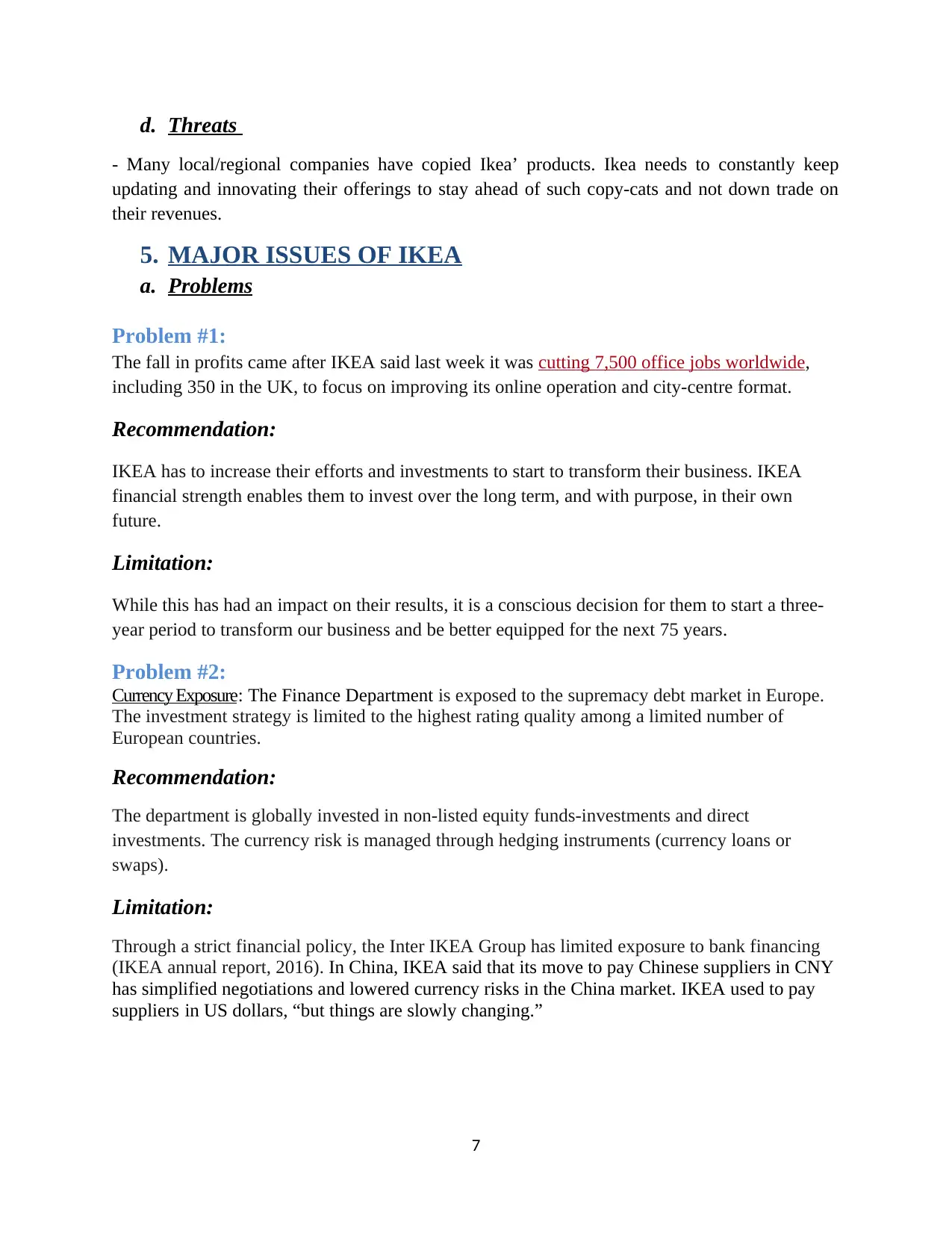
d. Threats
- Many local/regional companies have copied Ikea’ products. Ikea needs to constantly keep
updating and innovating their offerings to stay ahead of such copy-cats and not down trade on
their revenues.
5. MAJOR ISSUES OF IKEA
a. Problems
Problem #1:
The fall in profits came after IKEA said last week it was cutting 7,500 office jobs worldwide,
including 350 in the UK, to focus on improving its online operation and city-centre format.
Recommendation:
IKEA has to increase their efforts and investments to start to transform their business. IKEA
financial strength enables them to invest over the long term, and with purpose, in their own
future.
Limitation:
While this has had an impact on their results, it is a conscious decision for them to start a three-
year period to transform our business and be better equipped for the next 75 years.
Problem #2:
Currency Exposure: The Finance Department is exposed to the supremacy debt market in Europe.
The investment strategy is limited to the highest rating quality among a limited number of
European countries.
Recommendation:
The department is globally invested in non-listed equity funds-investments and direct
investments. The currency risk is managed through hedging instruments (currency loans or
swaps).
Limitation:
Through a strict financial policy, the Inter IKEA Group has limited exposure to bank financing
(IKEA annual report, 2016). In China, IKEA said that its move to pay Chinese suppliers in CNY
has simplified negotiations and lowered currency risks in the China market. IKEA used to pay
suppliers in US dollars, “but things are slowly changing.”
7
- Many local/regional companies have copied Ikea’ products. Ikea needs to constantly keep
updating and innovating their offerings to stay ahead of such copy-cats and not down trade on
their revenues.
5. MAJOR ISSUES OF IKEA
a. Problems
Problem #1:
The fall in profits came after IKEA said last week it was cutting 7,500 office jobs worldwide,
including 350 in the UK, to focus on improving its online operation and city-centre format.
Recommendation:
IKEA has to increase their efforts and investments to start to transform their business. IKEA
financial strength enables them to invest over the long term, and with purpose, in their own
future.
Limitation:
While this has had an impact on their results, it is a conscious decision for them to start a three-
year period to transform our business and be better equipped for the next 75 years.
Problem #2:
Currency Exposure: The Finance Department is exposed to the supremacy debt market in Europe.
The investment strategy is limited to the highest rating quality among a limited number of
European countries.
Recommendation:
The department is globally invested in non-listed equity funds-investments and direct
investments. The currency risk is managed through hedging instruments (currency loans or
swaps).
Limitation:
Through a strict financial policy, the Inter IKEA Group has limited exposure to bank financing
(IKEA annual report, 2016). In China, IKEA said that its move to pay Chinese suppliers in CNY
has simplified negotiations and lowered currency risks in the China market. IKEA used to pay
suppliers in US dollars, “but things are slowly changing.”
7
Paraphrase This Document
Need a fresh take? Get an instant paraphrase of this document with our AI Paraphraser
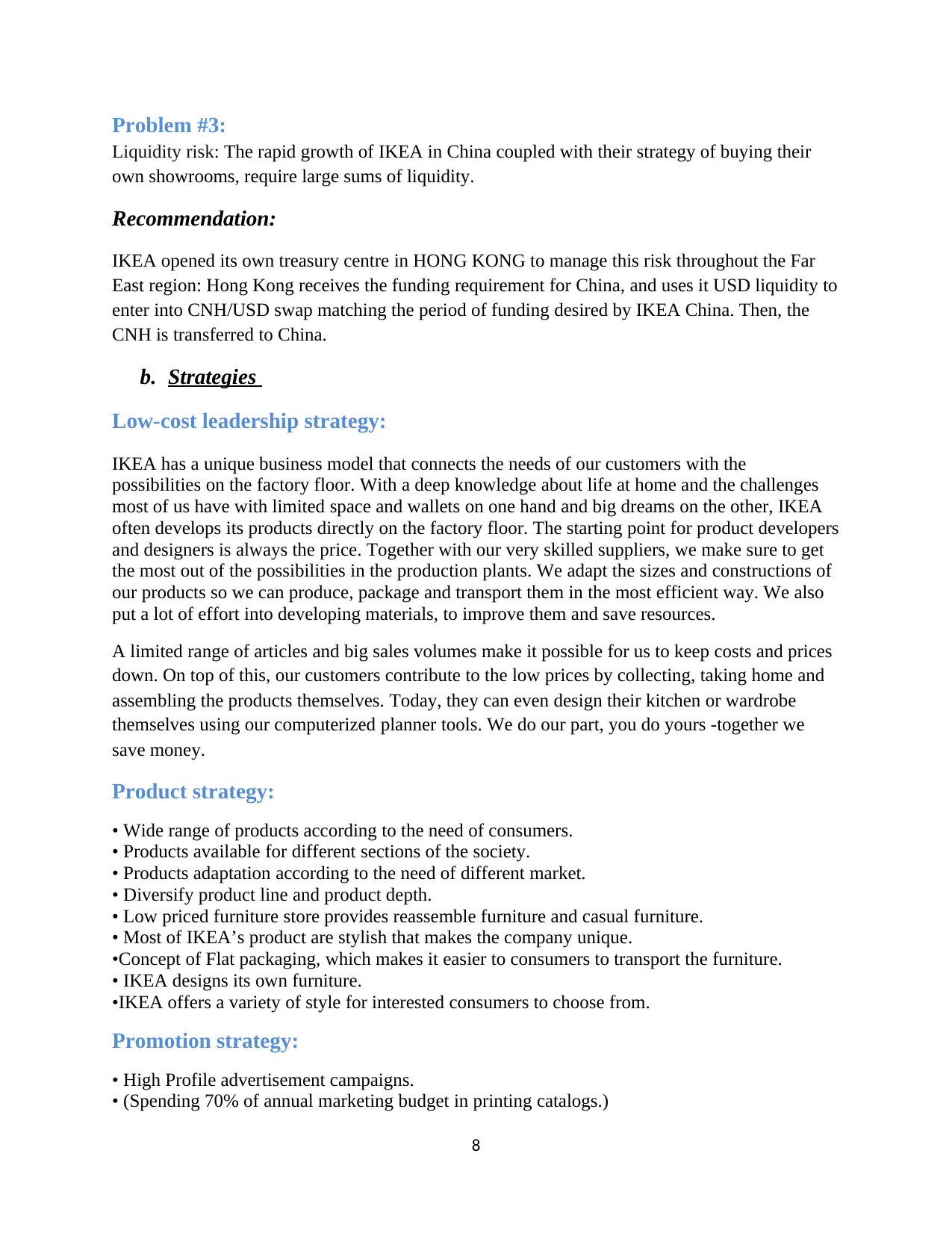
Problem #3:
Liquidity risk: The rapid growth of IKEA in China coupled with their strategy of buying their
own showrooms, require large sums of liquidity.
Recommendation:
IKEA opened its own treasury centre in HONG KONG to manage this risk throughout the Far
East region: Hong Kong receives the funding requirement for China, and uses it USD liquidity to
enter into CNH/USD swap matching the period of funding desired by IKEA China. Then, the
CNH is transferred to China.
b. Strategies
Low-cost leadership strategy:
IKEA has a unique business model that connects the needs of our customers with the
possibilities on the factory floor. With a deep knowledge about life at home and the challenges
most of us have with limited space and wallets on one hand and big dreams on the other, IKEA
often develops its products directly on the factory floor. The starting point for product developers
and designers is always the price. Together with our very skilled suppliers, we make sure to get
the most out of the possibilities in the production plants. We adapt the sizes and constructions of
our products so we can produce, package and transport them in the most efficient way. We also
put a lot of effort into developing materials, to improve them and save resources.
A limited range of articles and big sales volumes make it possible for us to keep costs and prices
down. On top of this, our customers contribute to the low prices by collecting, taking home and
assembling the products themselves. Today, they can even design their kitchen or wardrobe
themselves using our computerized planner tools. We do our part, you do yours -together we
save money.
Product strategy:
• Wide range of products according to the need of consumers.
• Products available for different sections of the society.
• Products adaptation according to the need of different market.
• Diversify product line and product depth.
• Low priced furniture store provides reassemble furniture and casual furniture.
• Most of IKEA’s product are stylish that makes the company unique.
•Concept of Flat packaging, which makes it easier to consumers to transport the furniture.
• IKEA designs its own furniture.
•IKEA offers a variety of style for interested consumers to choose from.
Promotion strategy:
• High Profile advertisement campaigns.
• (Spending 70% of annual marketing budget in printing catalogs.)
8
Liquidity risk: The rapid growth of IKEA in China coupled with their strategy of buying their
own showrooms, require large sums of liquidity.
Recommendation:
IKEA opened its own treasury centre in HONG KONG to manage this risk throughout the Far
East region: Hong Kong receives the funding requirement for China, and uses it USD liquidity to
enter into CNH/USD swap matching the period of funding desired by IKEA China. Then, the
CNH is transferred to China.
b. Strategies
Low-cost leadership strategy:
IKEA has a unique business model that connects the needs of our customers with the
possibilities on the factory floor. With a deep knowledge about life at home and the challenges
most of us have with limited space and wallets on one hand and big dreams on the other, IKEA
often develops its products directly on the factory floor. The starting point for product developers
and designers is always the price. Together with our very skilled suppliers, we make sure to get
the most out of the possibilities in the production plants. We adapt the sizes and constructions of
our products so we can produce, package and transport them in the most efficient way. We also
put a lot of effort into developing materials, to improve them and save resources.
A limited range of articles and big sales volumes make it possible for us to keep costs and prices
down. On top of this, our customers contribute to the low prices by collecting, taking home and
assembling the products themselves. Today, they can even design their kitchen or wardrobe
themselves using our computerized planner tools. We do our part, you do yours -together we
save money.
Product strategy:
• Wide range of products according to the need of consumers.
• Products available for different sections of the society.
• Products adaptation according to the need of different market.
• Diversify product line and product depth.
• Low priced furniture store provides reassemble furniture and casual furniture.
• Most of IKEA’s product are stylish that makes the company unique.
•Concept of Flat packaging, which makes it easier to consumers to transport the furniture.
• IKEA designs its own furniture.
•IKEA offers a variety of style for interested consumers to choose from.
Promotion strategy:
• High Profile advertisement campaigns.
• (Spending 70% of annual marketing budget in printing catalogs.)
8
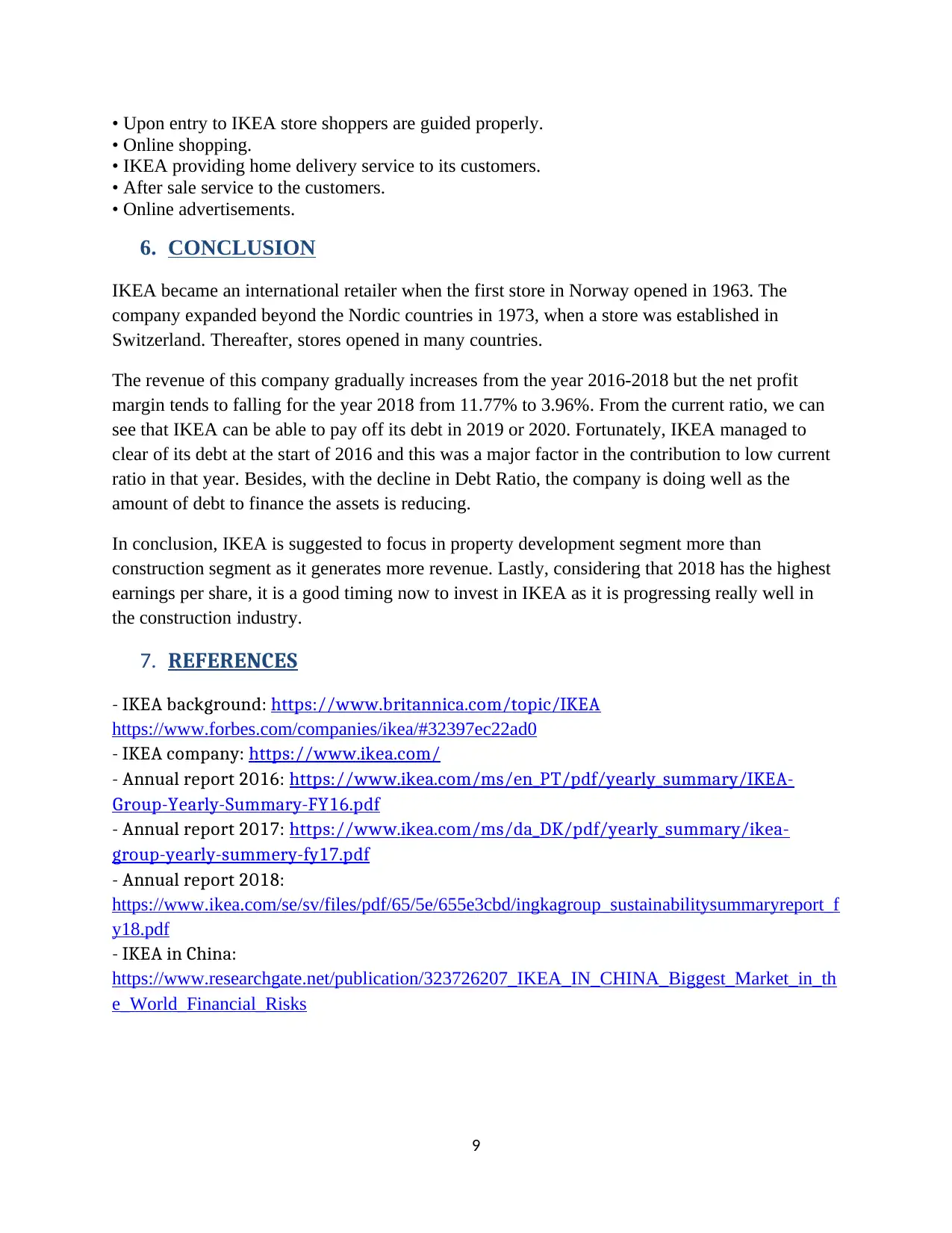
• Upon entry to IKEA store shoppers are guided properly.
• Online shopping.
• IKEA providing home delivery service to its customers.
• After sale service to the customers.
• Online advertisements.
6. CONCLUSION
IKEA became an international retailer when the first store in Norway opened in 1963. The
company expanded beyond the Nordic countries in 1973, when a store was established in
Switzerland. Thereafter, stores opened in many countries.
The revenue of this company gradually increases from the year 2016-2018 but the net profit
margin tends to falling for the year 2018 from 11.77% to 3.96%. From the current ratio, we can
see that IKEA can be able to pay off its debt in 2019 or 2020. Fortunately, IKEA managed to
clear of its debt at the start of 2016 and this was a major factor in the contribution to low current
ratio in that year. Besides, with the decline in Debt Ratio, the company is doing well as the
amount of debt to finance the assets is reducing.
In conclusion, IKEA is suggested to focus in property development segment more than
construction segment as it generates more revenue. Lastly, considering that 2018 has the highest
earnings per share, it is a good timing now to invest in IKEA as it is progressing really well in
the construction industry.
7. REFERENCES
- IKEA background: https://www.britannica.com/topic/IKEA
https://www.forbes.com/companies/ikea/#32397ec22ad0
- IKEA company: https://www.ikea.com/
- Annual report 2016: https://www.ikea.com/ms/en_PT/pdf/yearly_summary/IKEA-
Group-Yearly-Summary-FY16.pdf
- Annual report 2017: https://www.ikea.com/ms/da_DK/pdf/yearly_summary/ikea-
group-yearly-summery-fy17.pdf
- Annual report 2018:
https://www.ikea.com/se/sv/files/pdf/65/5e/655e3cbd/ingkagroup_sustainabilitysummaryreport_f
y18.pdf
- IKEA in China:
https://www.researchgate.net/publication/323726207_IKEA_IN_CHINA_Biggest_Market_in_th
e_World_Financial_Risks
9
• Online shopping.
• IKEA providing home delivery service to its customers.
• After sale service to the customers.
• Online advertisements.
6. CONCLUSION
IKEA became an international retailer when the first store in Norway opened in 1963. The
company expanded beyond the Nordic countries in 1973, when a store was established in
Switzerland. Thereafter, stores opened in many countries.
The revenue of this company gradually increases from the year 2016-2018 but the net profit
margin tends to falling for the year 2018 from 11.77% to 3.96%. From the current ratio, we can
see that IKEA can be able to pay off its debt in 2019 or 2020. Fortunately, IKEA managed to
clear of its debt at the start of 2016 and this was a major factor in the contribution to low current
ratio in that year. Besides, with the decline in Debt Ratio, the company is doing well as the
amount of debt to finance the assets is reducing.
In conclusion, IKEA is suggested to focus in property development segment more than
construction segment as it generates more revenue. Lastly, considering that 2018 has the highest
earnings per share, it is a good timing now to invest in IKEA as it is progressing really well in
the construction industry.
7. REFERENCES
- IKEA background: https://www.britannica.com/topic/IKEA
https://www.forbes.com/companies/ikea/#32397ec22ad0
- IKEA company: https://www.ikea.com/
- Annual report 2016: https://www.ikea.com/ms/en_PT/pdf/yearly_summary/IKEA-
Group-Yearly-Summary-FY16.pdf
- Annual report 2017: https://www.ikea.com/ms/da_DK/pdf/yearly_summary/ikea-
group-yearly-summery-fy17.pdf
- Annual report 2018:
https://www.ikea.com/se/sv/files/pdf/65/5e/655e3cbd/ingkagroup_sustainabilitysummaryreport_f
y18.pdf
- IKEA in China:
https://www.researchgate.net/publication/323726207_IKEA_IN_CHINA_Biggest_Market_in_th
e_World_Financial_Risks
9
1 out of 9
Related Documents
Your All-in-One AI-Powered Toolkit for Academic Success.
+13062052269
info@desklib.com
Available 24*7 on WhatsApp / Email
![[object Object]](/_next/static/media/star-bottom.7253800d.svg)
Unlock your academic potential
© 2024 | Zucol Services PVT LTD | All rights reserved.





